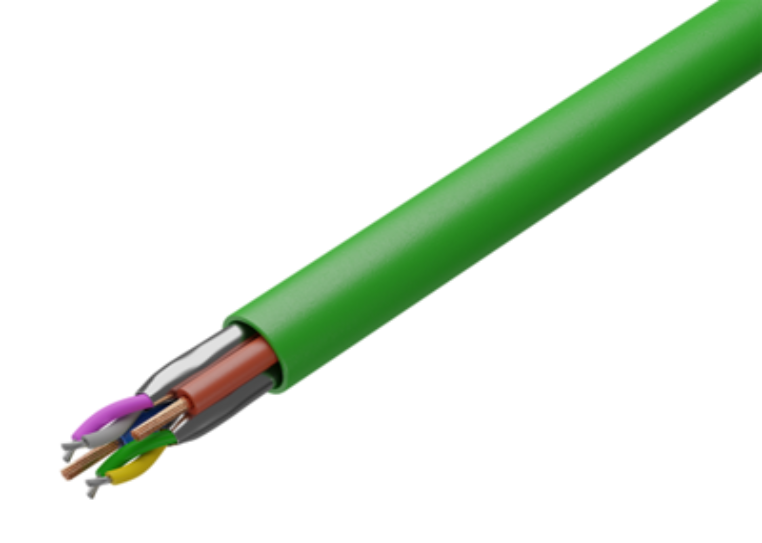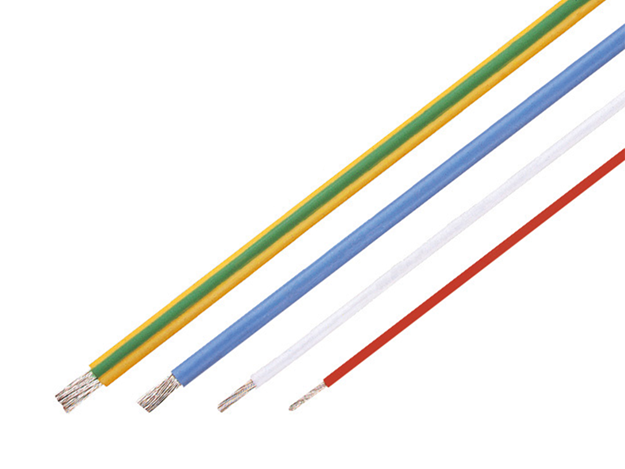Halogen-free cables and the related regulations
In this article, TME will define the different kind of halogen-free cables and the related regulations and dive into some of the options available.
When buying cables and wiring, we often see them marked as ‘halogen-free’, ‘self-extinguishing’ or described by mysterious acronyms such as ‘LSZH’. But what exactly do these refer to? In this article, we will define their meaning for you.
Cable construction is much more complicated than an average person would think. This topic involves more than just cable conductors and their ability to conduct currents of different intensities or signals of a specific frequency. When it comes to looking for a right product for a given application, its insulation, i.e. the material that was used to make the cable’s outer (and inner) jacketing, and its properties turn out to be very significant variables. Below, you can find some examples of popular phrases, certifications and characteristics used by manufacturers to describe their products.
In this article, you will read about:
- Definition of ‘halogen-free’
- What do the LSZH and FRNC acronyms stand for?
- Safe insulation materials used in wiring
- Why is it important to pay attention to the CPR standard?
- How are cables classified in terms of their flammability?
What does ‘halogen-free’ mean?
Halogens, or group 17 elements, include fluorine, chlorine, bromine, iodine and astatine. They are chemical elements that form salts and can be found in some strong acids (including, of course, hydrochloric acid). They are toxic, to the point where they pose a threat to human life, both in a gaseous state and as smoke resulting from burning. Halogens are used in the production of many different plastics to give them the desired properties. Then, such plastics are used to make wire insulations the most popular example here is PVC, i.e. polyvinyl chloride, which is a chlorine compound.
The absence of halogen compounds most often results in less harmful effects of the smoke released during the burning of plastics. This characteristic is of key importance in the context of fire safety. When there’s a fire, toxic gas can be as dangerous as flames or high temperature. That is why there is an increasing emphasis on the use of halogen-free materials, especially when manufacturing cables intended for use in living spaces, offices or transportation (automotive and railway industries). Luckily, research in the field of chemistry has made it possible to develop many alternative, less toxic materials in the last few decades. As a consequence, the cost of production of such materials and their derivatives (including cables with halogen-free insulation) has been significantly lowered. Many of the top manufacturers, e.g. German brand HELUKABEL, offer a wide range of such products, which not only provide excellent protection for the contractors and users of electrical installations, but also increase safety for others in case of fire.

KH-BUS-81447
Halogen-free cables are manufactured with industrial applications in mind, among other things.
LSZH
LSZH stands for Low Smoke Zero Halogen, and describes materials which emit limited amount of smoke (during combustion) and don’t contain halogen compounds. This acronym is used e.g. when describing the material from which cables are made. However, note that it doesn’t name the specific chemical compound, but only refers to its properties. HELUKABEL also manufactures this type of products, e.g. the JZ-500 and OZ500 series multicore control cables.
FRNC
It is another acronym that describes material properties. It stands for .Flame Retardant, Non Corrosive, which means that the insulation is self-extinguishing (does not spread flames), and it doesn’t contain corrosive chemicals. In practice, this implies the use of halogen-free materials. When in contact with flame, this type of wiring mainly releases water vapour and carbon dioxide. It is another type of products offered by HELUKABEL.
Insulation materials
If the insulation material is that important when it comes to wiring and fire safety, it would be wise to get to know the materials which are used to make outer jackets. Although all of them, in one way or another, reduce the risk of vapour poisoning or at least increase the thermal tolerance of wiring, they also have other characteristics that should be kept in mind when making a purchase.
EPDM
EPDM is ethylene-propylene-diene rubber,i.e. a type of synthetic rubber. Its most significant characteristics include resistance to hot water and water vapour, as well as to alcohols, which is why it’s used to manufacture coolant hoses for motor vehicles, among other things. Wiring made with this kind of material boasts resistance to UV exposure and slowed down aging caused by environmental conditions.
(Cross-linked) polyethylene
Polyethylene is a type of thermoplastic material, whose elasticity, mechanical and thermal properties meet the needs of most types of wiring. It often contains cross-link bonds. In the process of manufacture, this type of polyethylene is subjected to an electron beam, which triggers a chemical reaction that results in additional enhancement of the coating. As a result, apart from flame resistance and electrical (and thermal) insulation properties, the coating additionally exhibits high mechanical durability and longer service life than jackets made from, e.g. PVC. Polyethylene is a part of a larger group of chemical compounds, polyolefins (sometimes that name is used to refer to the material from which the insulation is made). Due to their stable chemical composition, cables with polyethylene jackets are used in very harsh environments, for example to power deep-sea submersible pumps.
PUR
An important and distinguishing property of polyurethane insulations is that they retain their flexibility in a wide range of temperatures. They also boast high mechanical resistance (abrasion and wear) and resistance to UV radiation (sunlight). Unfortunately, because of their structure, PUR insulations don’t guarantee moisture resistance, as they are vulnerable to hydrolysis, i.e. slow decomposition as a result of contact with water.
Silicone
Silicone jacketed cables are a bit more expensive, but also exceptionally durable. Their most significant assets include high flash point, resistance to many chemical compounds, wide thermal tolerance (200°C and even higher) and great flexibility. Due to such a high quality, silicone cables are used in measuring or mounting applications. In the TME catalogue, silicone cables are grouped under a separate category.
CPR and EN50575
CPR (Construction Products Regulation) is a regulation that is in effect in the EU countries. Its main purpose is to regulate issues related to materials used in construction, in particular their susceptibility to fire and their behaviour when exposed to flames. The regulation classifies wiring in terms of the ignition point, chemical compounds visible during combustion, etc. The CPR makes it possible to clearly determine the class (‘Euroclass’) of a given product – it is done through laboratory testing (as described in the EN50575 standard). Those interested in purchasing the wiring (e.g. developers or installers) should mainly pay attention to two types of cables: Eca and Dca. The former can be used in freestanding residential buildings, garages, agricultural and forestry holdings. The requirements for the Dca cables are more stringent, thanks to which they can be installed in high-rise and tall buildings (more than a dozen floors), schools, kindergartens or public utility buildings. However, it is important to note that this type of wiring is not allowed in escape route areas. Brand-name suppliers make sure to manufacture a wide variety of wires that are compliant with various classifications for photovoltaic, installation, control or even speaker and ICT applications.
Flammability classes and classifications
The last issue (somewhat similar to the CPR standard) that needs to be addressed when talking about wiring safety is its flammability class. There are several symbols that are used to denote it, but the most popular ones that are worth remembering are the UL94 and ECE R-118 standards.
UL94
UL94 is a standard developed in the USA, which makes it possible to predict how a given material will behave in case of fire or, to be more precise, in any contact with flames. It’s a multi-level classification that is applied to plastic materials. In the case of cable insulations, the most common ratings are UL94V-0 and UL94V-2. The former means that the burning stops within 10 seconds after the flame is removed. Dripping of molten plastic can occur, as long as the droplets are not inflamed. The lower class of flammability (V-2) allows for inflamed droplets of plastic, and the time of burning is extended to 30 seconds. The UL94 tests are conducted through igniting a vertically placed sample (approx. 12 cm long) of the material.
ECE R-118

HTERM145-0.25BK
HELUTHERM 145 cables compliant with ECE R-118 for automotive applications
The 118 designation is present in many countries, as it comes from the UN Regulation No. 118. ECE stands for Economic Commission for Europe. The aim of the ECE R-118 regulation is to make uniform the international technical prescriptions concerning the burning behaviour of materials used in the construction of passenger cars. First and foremost, it is concerned with the components of passenger compartments, i.e. doors, floor, dashboard/cockpit, etc. Naturally, in modern cars all these components are electrified and full of sensors, switches, electronic circuits and actuators. All of them are subjected to the abovementioned regulation, and so is their wiring, i.e. all the cables and wires used in underfloor and overhead harnesses, for connecting the sound system, etc.
Compliance with the ECE R-118 standard is a key feature when it comes to cables which are meant to be used in the automotive industry. The HELUTHERM 145 series from HELUKABEL can serve as an example of such products. High thermal tolerance is achieved through cross-linked insulation, which is resistant even to soldering tips whose temperature can reach up to 380°C.










